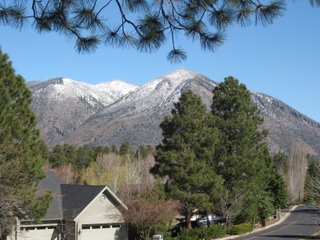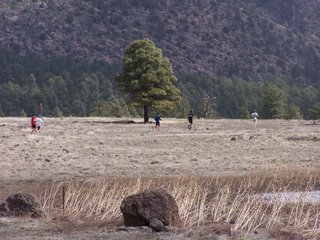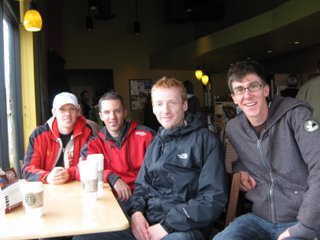P-K on the Left Coast
This week's post comes to you from beautiful Port Coquitlam B.C., where P-Ker Rejean Chiasson and I are recovering from the first of two big 10ks-- by the numbers, Canada's two biggest 10ks, in fact. Yesterday, the two of us were joined by D. Wykes on the start line of the Vancouver Sun Run, Canada's largest race, with an entry list 60,000 names long. Thirty-one minutes and nine seconds later we were all safely across the line. Another 60mins later, we were all on the big awards podium (and on the jumbo-tron!)inside BC Place, with Dylan having placed a hard-fought 2nd to resident Kenyan Willy Komosop (in a road P.B.--29:12), Rejean having battled to a P.B. of his own in coming 5th place among Canadians and 8th over-all(earning his first ever prize money in the process), and yours truly having finished 2nd master, but in a new 45-49 Canadian record of 31:09(pending ratification, as the course may be officially considered "aided"). Rejean and I were well pleased with our efforts, while Dylan, believing with good cause that he could win the race, was of mixed mood-- happy about his shape, but a little disappointed with his finish place. He will return to Flagstaff for a final two weeks of altitude preparation before tackling his seasonal goal race-- the Cardinal Invitational 10,000m in Palo Alto California.
Rejean and I will spend the remainder of the week here in "PoCo" with my old and very dear friends Richard and Sue Lee (Sue, a two time Olympian and former Canadian 10,000m record holder, also happens to have been the winner of the first Sun Run, 25 years ago). On Friday, we will cross over to the island for Sunday's Times-Colonist 10-- the Sun Run's little brother, with a mere 13,000 entries (although capped).
The Sun Run and Times-Colonist 10ks are spectacular harbingers of the beautiful B.C. spring time. They also represent triumphs of successful sport and fitness promotion. Both started on a fairly modest scale and have been slowly built to their current size through the simple medium of newspaper support (the Vancouver Sun and Times-Colonist papers run daily run-training segments and other race-related stories starting in early January that serve as encouraging reminders to potential entrants to get themselves into shape in time for the big day). Each year, thousands of B.C. residents from the Lower Mainland and Island challenge co-workers and family members to toe the line in these athletic rites of spring. Along with the fabulous array of immaculately maintained parks, running, biking and hiking trails found in virtually all municipalities out here, the Sun Run and Times-Colonist 10ks are two more reasons why B.C. residents are on average the most fit Canadians in the federation and, indeed, among the most fit people in all of North America. While smaller jurisdictions could never hope to replicate the full scale of Sun Run and T-C events, there are simple lessons to be learned from these races about how to promote running as both a mass-fitness activity and a competitive sport. Through the effective use of one old medium-- the daily print newspaper--and one very old one--word of mouth-- the sponsors and organizers of these events have managed to encourage tens of thousands ordinary residents to accept the challenge of running and walking over 10kms of their community's streets. And, through a dedication to the competitive sides of things-- the sponsorship, through travel support and prize money, of top fields of Canadian and international distance runners-- the Sun Run and T-C have provided a needed boost to elite sport in this country. (In addition, a significant percentage of the proceeds from the Sun Run go to support the annual Harry Jerome International Track Classic, which provides a rare North American venue for world class track and field competition).
So, with the temperatures warming up nicely and the buds beginning to burst, Rejean and I will spend the remainder of the week soaking up all that B.C. has to offer in the form of soft trails and beautiful vistas. On Sunday, we will line up once again in front of the massive throngs, hoping for even faster times (and perhaps a little cash, to keep things interesting!)
P.S. I, in particular, will be hoping for another decent time. With the Sun Run possibly considered and "aided" course (due to the net elevation drop), I'll need another 31:31 or better to erase the old national 45-49 record.
Rejean and I will spend the remainder of the week here in "PoCo" with my old and very dear friends Richard and Sue Lee (Sue, a two time Olympian and former Canadian 10,000m record holder, also happens to have been the winner of the first Sun Run, 25 years ago). On Friday, we will cross over to the island for Sunday's Times-Colonist 10-- the Sun Run's little brother, with a mere 13,000 entries (although capped).
The Sun Run and Times-Colonist 10ks are spectacular harbingers of the beautiful B.C. spring time. They also represent triumphs of successful sport and fitness promotion. Both started on a fairly modest scale and have been slowly built to their current size through the simple medium of newspaper support (the Vancouver Sun and Times-Colonist papers run daily run-training segments and other race-related stories starting in early January that serve as encouraging reminders to potential entrants to get themselves into shape in time for the big day). Each year, thousands of B.C. residents from the Lower Mainland and Island challenge co-workers and family members to toe the line in these athletic rites of spring. Along with the fabulous array of immaculately maintained parks, running, biking and hiking trails found in virtually all municipalities out here, the Sun Run and Times-Colonist 10ks are two more reasons why B.C. residents are on average the most fit Canadians in the federation and, indeed, among the most fit people in all of North America. While smaller jurisdictions could never hope to replicate the full scale of Sun Run and T-C events, there are simple lessons to be learned from these races about how to promote running as both a mass-fitness activity and a competitive sport. Through the effective use of one old medium-- the daily print newspaper--and one very old one--word of mouth-- the sponsors and organizers of these events have managed to encourage tens of thousands ordinary residents to accept the challenge of running and walking over 10kms of their community's streets. And, through a dedication to the competitive sides of things-- the sponsorship, through travel support and prize money, of top fields of Canadian and international distance runners-- the Sun Run and T-C have provided a needed boost to elite sport in this country. (In addition, a significant percentage of the proceeds from the Sun Run go to support the annual Harry Jerome International Track Classic, which provides a rare North American venue for world class track and field competition).
So, with the temperatures warming up nicely and the buds beginning to burst, Rejean and I will spend the remainder of the week soaking up all that B.C. has to offer in the form of soft trails and beautiful vistas. On Sunday, we will line up once again in front of the massive throngs, hoping for even faster times (and perhaps a little cash, to keep things interesting!)
P.S. I, in particular, will be hoping for another decent time. With the Sun Run possibly considered and "aided" course (due to the net elevation drop), I'll need another 31:31 or better to erase the old national 45-49 record.


